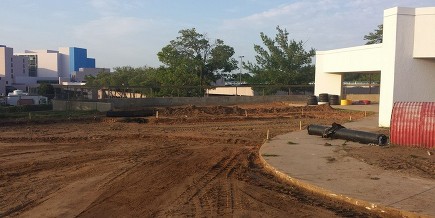Professional Grading and Land Clearing
Everything Outdoors of Tulsa has a complete team of professional grading and land clearing personnel on staff to take care of any type of Tulsa excavation.
Below are some tips to keep in mind:
Applicability
Land grading is applicable to sites with uneven or steep topography or easily erodible soils, because it stabilizes slopes and decreases runoff velocity. Grading activities should maintain existing drainage patterns as much as possible.
Siting and Design Considerations
Before grading activities begin, a construction site operator must make decisions regarding the steepness of cut-and-fill slopes and how the slopes will be
- Protected from runoff
- Stabilized
- Maintained
Prepare a grading plan that establishes which areas of the site will be graded, how drainage patterns will be directed, and how runoff velocities will affect receiving waters. Also in the grading plan, include information about when earthwork will start and stop, establish the degree and length of finished slopes, and dictate where and how excess material will be disposed of (or where borrow materials will be obtained if needed). Land grading should be a key consideration for Construction Sequencing. Try to minimize exposed soils at any given time during construction. Incorporate in the plan any berms, diversions, and other stormwater practices that require excavation and filling.
Care should be taken if blasting agents or explosives are used. These products may contain perchlorates, which are water soluble chemicals. If explosives containing perchlorate must be used, then good housekeeping practices should be employed to ensure that any debris is properly disposed.
A low-impact development BMP that a site operator can incorporate into a grading plan is site fingerprinting, which involves clearing and grading only those areas necessary for building activities and equipment traffic. Maintaining undisturbed temporary or permanent buffer zones in the grading operation provides a low-cost sediment control measure that will help reduce runoff and offsite sedimentation. Let the lowest elevation of the site remain undisturbed to provide a protected stormwater outlet before storm drains or other construction outlets are installed.
Limitations
Improper grading practices that disrupt natural stormwater patterns might lead to poor drainage, high-runoff velocities, and increased peak flows during storm events. Clearing and grading the entire site without vegetated buffers promotes offsite transport of sediments and other pollutants. Design the grading plan with erosion and sediment control and stormwater management goals in mind; to ensure that the plan is implemented as intended, carefully supervise grading crews.
Maintenance Considerations
Check all graded areas and supporting erosion and sediment control practices periodically, especially after heavy rainfalls. Promptly remove all sediment from diversions or other stormwater conveyances, and if washouts or breaks occur, repair them immediately. To prevent small-scale eroded areas from becoming significant gullies, maintain them promptly.
Effectiveness
Land grading is an effective way to reduce steep slopes and stabilize highly erodible soils when properly implemented with stormwater management and erosion and sediment control practices. Call us today to be your Broken Arrow / Tulsa landscaping company!







